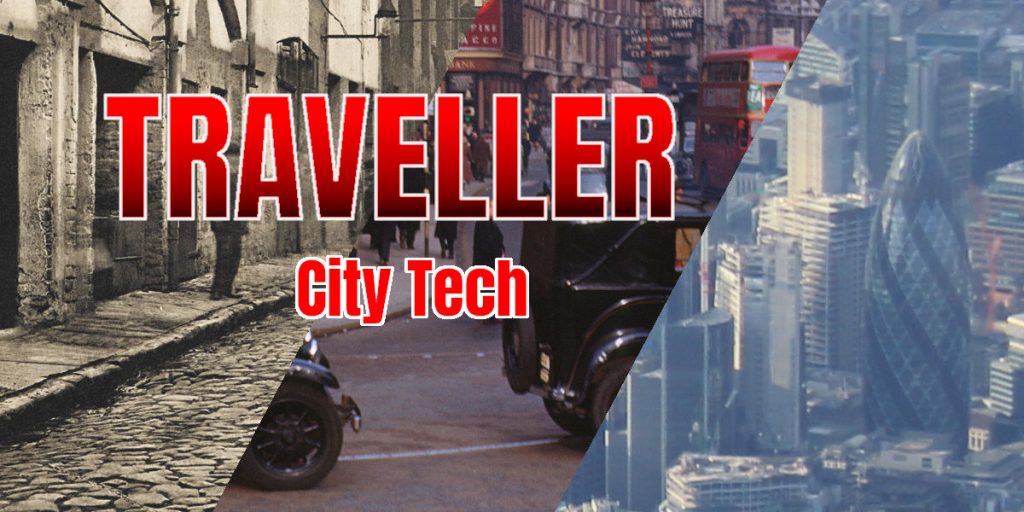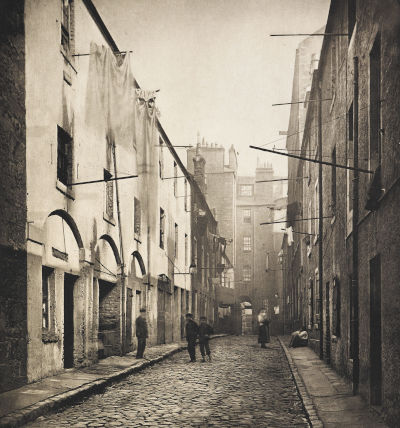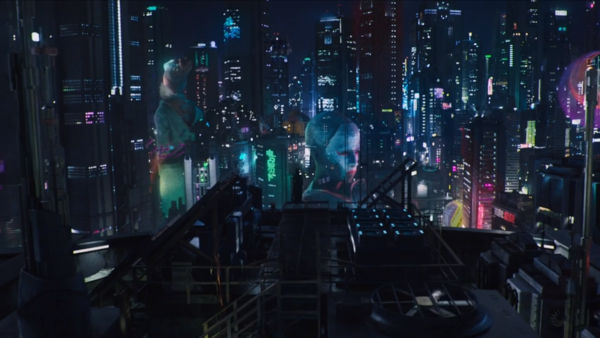City Tech

Writing up worlds for Traveller, I’m trying to get an idea of what a world’s civilisation actually looks like, beyond it just being “futuristic”. So I’m going through the various Traveller Technology Levels and trying to think about what a city at that technology level might look like. Obviously, there will be lots of variations, and some worlds may be importing technology from elsewhere, but it’s an attempt to get a general baseline for worlds.
For completeness, I’ve started at TL 0, which is the stone age, going up to TL 15 at the highest level.
Part of the title image is copyright CC-BY-SA from here.
One complication is that according to the (Mongoose) Traveller rules, technology doesn’t often become cheaper at higher Tech Levels. Cybernetics for example which are introduced at TL 10 are costly, and remain costly all the way up to TL 15 rather than becoming affordable for everyone. This makes some of my normal assumptions, that tech that is rare at one TL should become commonplace at a later TL, not quite work.
Pre-Industrial
Prior to TL 2 there often isn’t much to differentiate these worlds as far as a Traveller is concerned. They could all be tribal or city based, the difference being in whether they use stone, bronze or iron for their tools and weapons.
There may be northern European settlements in the manner of vikings or saxons, or there could be huge city states such as Rome (TL 1) or the Aztecs (TL 0). All of these cultures can have writing, trade and a complex economy.
TL 2 is a small improvement, in that writing and complex economy is pretty much required by this point, and explorers will be bringing back goods and stories from half way around the world.
All of them could potentially have a large city with a population of a million or more, with huge markets and complicated social structures.
Industrial
TL 3 – Industrial Revolution

A TL 3 society will have something earlier societies didn’t have – factories, machines and smog. Culture is moving from a mostly rural to a mostly urban focus, with large factories full of workers and steam powered machines being a major feature of those cities.
Large cities will tend to have chimneys belching smoke, there will be high density housing for the workers and general quality of life will be poor for most people in urban environments. Prior to TL 3 cities were smelly. Now they are smelly, dark and grimy.
Whilst factories use steam power, animal power will still be common, especially where mobility is required such as in farming or for moving goods or people. The exception might be steam trains or ships, the latter of which will be starting to replace sailing ships.
Think Victorian London. The above video gives a good idea of what a city this tech level would be like.
TL 4-5 – Mechanisation
Though industrialisation in TL 3 kicks off the use of machines, they start to become consumer products in TL 4 and city streets start to fill with mechanised vehicles rather than just animals, becoming pretty much the standard by TL 5.
Electric lighting become common in TL 4, and by TL 5 cities are still grimy but they can be brightly lit at night. Long distance communication by radio or telephone becomes possible and then quickly commonplace. Likewise, heavier than air flight is invented early in TL 4, and is common by the end of TL 5.
For a culture that has contact with off-world trade, TL 4 will quickly progress to TL 5 because they’ll be able to reverse engineer advances such as medicine, chemistry and electronics without too much difficulty, especially if they’re able to buy good quality tools and some simple science books.
Long distance communication, as well as sound recordings can lead to a boom in the music culture. This will be especially true on a world which can import music (and even video) from off-world. People begin to have the spare time to enjoy such things in large numbers.
TL 6 – Atomic
This is the America of the mid 20th century. Use of animals for transport is pretty much gone, with wheeled vehicles for short travel and planes or steam ships for long distance travel.
Cities will be bright at night, with electric lighting, audio communications and broadcast video. With help from off-world technology, reliance on satellites for communication will probably be common place.
There will be a large desire for off world consumer electronics, though not much of a computer infrastructure to support it.
Such cities will be moving towards favouring a service industry over heavy industrial factories, though the latter will still exist and remain a staple for a while to come.
Information
TL 7 – Electronic
The late 20th century, with a rapid growth in electronics and computers. Modern medicine is widespread, televisions are everywhere and most urban cities are dominated by wheeled cars.
Cities will be full of tall glass buildings, with heavy industry mostly moved out of the city leaving room for commerce and residential buildings.
TL 8 – Communication
This is early 21st century Earth, pretty much an extension of TL 7, but things will be shinier and TVs will be flatter. Everyone will have a personal communications device, and access to a world wide computer network.
The Near Future
TL 9 – Gravitics
With the invention of anti-gravity, everything begins to change. Not only does it allow cheap access to orbit, but it can also be a game changer for personal transport. Initially, orbital access is where it has the first impact, so TL 9 societies will tend to begin construction of a much larger orbital infrastructure. For personal transport, it’s probably too early for a huge impact, since cities will have been built for wheeled transport and it’ll take a while to make the change to flying cars.
However, roof top garages and landing pads will begin to become more common, especially in wealthy districts. Wherever someone had a helicopter landing pad, they will now support grav vehicles. Pretty much all vehicles will be electric at this point, making inner cities a lot cleaner than they were prior to TL 9.
Small holographic displays start to become available, changing the look for shop windows and maybe street signs.
TL 10 – Practical Fusion
Cheap power has been promised since TL 6, but it now becomes possible. Grav vehicles will have almost completely taken over from wheeled vehicles, allowing for more pedestrianised areas down on the ground. Car parks are moving up, and power generation is moving to smaller and more numerous power plants. Solar and wind are probably still around though where it makes sense to use it.
Larger free standing holographic displays means that most store fronts will be making use of holographic advertising. Plazas will begin to use large holograms in place of statues or notice boards, though they won’t be the building sized things of later TLs.
Cybernetics is becoming practical, so seeing people with neural jacks or cybernetic limbs won’t be unusual, though it’ll tend to be limited to those with enough money to afford them.
Climate engineering or geoforming will be common, reshaping the world around the cities to better match the expectations of the population.
TL 11 – Infinite Power
With ubiquitous cheap power from improved fusion, there’s few limits to what people can do in terms of architecture and technology. Powering whole buildings to make use of anti-gravity is no longer an issue, so expensive office blocks or administration buildings may be permanently floating above the ground.
The rich will be affording houses in the clouds, only reachable by air cars, and automation of vehicles is standard, with few people actually piloting their vehicles instead relying on full AI control.

Extra power and improved technology means large building sized holograms are possible, and will be commonly used for holograms, and there will always be enough power for the full lighting of cities if desired.
Heavy industry will continue to move into space, where it’s just as easy, if not easier, to build things than on the surface and where pollution isn’t an issue.
The Far Future
TL 12 – Robots
Whole city blocks can move into the clouds, allowing more of the city to be handed back to nature, with parks and gardens becoming more common. Most of the population will still be ground based however, with either mass transit or air cars being the main method of transportation.
Robots are becoming more sophisticated, and starting to be used in jobs which previously were unique to biological sophonts. Robots begin to be seen outside of factories, serving tables, working in receptions or generally doing the shopping for their owners. However, robots are obviously robots, and attempts to make them look and act completely human generally fail.
Many people will have cheap neural comms implanted into themselves, which replaces the need for an external communication device. This provides audio and visual information directly to the eyes and ears over a secure link.
The combination of robots and neural comms makes the use of remotes possible, taking over control of a remote robot shell to do your work without leaving your home.
TL 13 – Cloning
Technological advances beyond TL 12 tend towards the biological or small scale, which has lesser effect on city architecture. Instead, changes become more personalised and intrusive.
By TL 13, most building exteriors will tend to be permanently decorated with holographic imagery, even if it’s simple 2D painting.
Real time updates on traffic, emergency situations or basic advertising, tailored directly to individuals will appear on walkways and store fronts. Local projectors can be used to project images directly based on a person’s personal comm, so you can sit down at a cafe and have your colleague appear as a holographic projection across from you and carry on a conversation. Embedded cameras in the local area will be able to project your holographic image back to them. Such technology can be seen as a complete invasion of privacy, but by this point it is assumed that if you’re in a public space you’ve given up all privacy, especially since it’s also possible to track people by their DNA using sensors built into doorways.
A decent holographic projector (especially the type found in office meeting rooms) is difficult to tell apart from the real thing. Projecting an image onto a remote robot to make it look like you is also possible.
Small electronic gadgets can be permanently powered from your own body energy, and where that isn’t possible wireless (at range) charging is available in most urban cafes for a small fee.
Advanced neural links do everything they could at TL 12, plus people can plug in physical skills.
TL 14 – Geneering
As for TL 13, changes are incremental in how cities look. Material science has increased to the point where smart materials are commonly used in building construction. Not only does this allow self-repair over time (enough to come with decay, but not direct physical damage), but also allows material properties to be dynamically programmed. Walls can become windows, a light source or display screens at a spoken command or thought from someone with a neural link. Holo-displays can also allow one-way windows in apartments, providing highly realistic views (and allowing in light that looks like it’s coming from the correct direction), which can zoom in on specific targets based on what your neural link knows you are looking at.
This level of programming isn’t available everywhere, but will be present in most office buildings and good quality residential houses or apartments.
Anyone with money will be born with a clean set of genes, greatly reducing inheritable diseases or simply ‘unlucky’ genes. A large proportion of the population will look like super models, which raises the bar for what is meant by beauty, and seriously disadvantages those at the lower end of the wealth scale.
Robotic automation means that most jobs no longer need to be done by biological sophonts, and almost limitless clean power means that such a civilisation is getting close to being post-scarcity. Food and other basic goods should be freely available, and medicine can cure most diseases or injuries, even bringing people back from the dead. Being ‘poor’ in such a civilisation may be significantly better than being well off on 21st century Earth. Except on the most extreme capitalist societies, there is no need for work to afford decent accommodation, food and clothing. Whether it’s possible to live a meaningful life depends on the people and the society.
TL 15 – Anagathics
In TL 14 everyone is beautiful, in TL 15 everyone looks young and beautiful, as anagathics become readily available. At least if you have the money.
There are few practical restrictions on architecture, with huge twisting towers floating in the clouds, wreathed in dynamic artistic holograms and surrounded by swarms of smaller buildings or floating gardens to be possible.
Most cities are open gardens on the surface, with a three dimensional array of buildings stretching up from that. Air cars or grav belts ferry people around when what they need to do can’t be done remotely through remote robots and holographic video calls.
The city knows where everyone is, for good or bad, and poverty often means boredom rather than hunger or lacking housing. For those who don’t like the real world, then virtual worlds are plentiful and almost limitless in what they can provide.
High population worlds will see much of the population living above the ground or in orbit, with little real difference between the two. Worlds which exist at the height of Imperium technology are often spheres of glittering jewels, and the concept of a city as a specific collection of buildings being somewhat outdated. If individual buildings can float to wherever they need to be, then the location of a city might be tied to a few important buildings rather than a specific point on the ground.